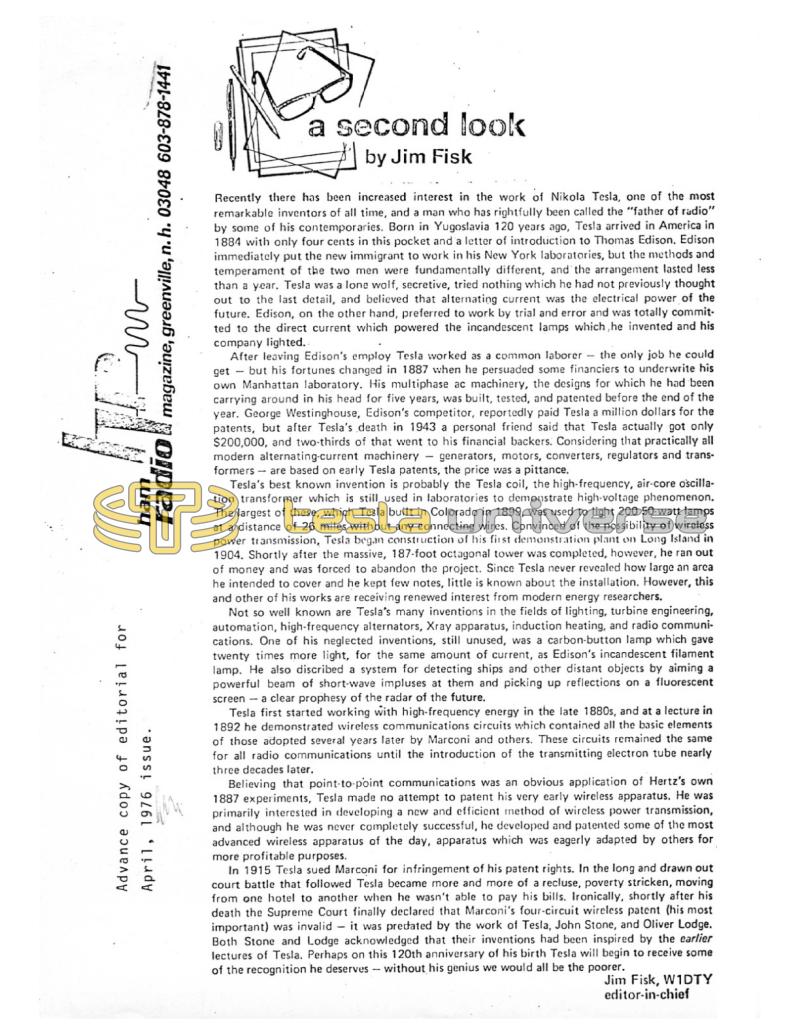
Nikola Tesla Articles
A Second Look - Recent Interest in the Work of Nikola Tesla
Recently there has been increased interest in the work of Nikola Tesla, one of the most remarkable inventors of all time, and a man who has rightfully been called the "father of radio" by some of his contemporaries. Born in Yugoslavia 120 years ago, Tesla arrived in America in 1884 with only four cents in this pocket and a letter of introduction to Thomas Edison. Edison immediately put the new immigrant to work in his New York laboratories, but the methods and temperament of the two men were fundamentally different, and the arrangement lasted less than a year. Tesla was a lone wolf, secretive, tried nothing which he had not previously thought out to the last detail, and believed that alternating current was the electrical power of the future. Edison, on the other hand, preferred to work by trial and error and was totally committed to the direct current which powered the incandescent lamps which he invented and his company lighted.
After leaving Edison's employ Tesla worked as a common laborer - the only job he could but his fortunes changed in 1887 when he persuaded some financiers to underwrite his own Manhattan laboratory. His multiphase ac machinery, the designs for which he had been carrying around in his head for five years, was built, tested, and patented before the end of the year. George Westinghouse, Edison's competitor, reportedly paid Tesla a million dollars for the patents, but after Tesla's death in 1943 a personal friend said that Tesla actually got only $200,000, and two-thirds of that went to his financial backers. Considering that practically all modern alternating-current machinery generators, motors, converters, regulators and transformers are based on early Tesla patents, the price was a pittance.
Tesla's best known invention is probably the Tesla coil, the high-frequency, air-core oscillation transformer which is still used in laboratories to demonstrate high-voltage phenomenon. The largest of these, which Tesla built in Colorado in 1899, was used to light 200 50-watt lamps at a distance of 26 miles without any connecting wires. Convinced of the possibility of wireless power transmission, Tesla began construction of his first demonstration plant on Long Island in 1904. Shortly after the massive, 187-foot octagonal tower was completed, however, he ran out of money and was forced to abandon the project. Since Tesla never revealed how large an arca: he intended to cover and he kept few notes, little is known about the installation. However, this and other of his works are receiving renewed interest from modern energy researchers.
Not so well known are Tesla's many inventions in the fields of lighting, turbine engineering, automation, high-frequency alternators, Xray apparatus, induction heating, and radio communications. One of his neglected inventions, still unused, was a carbon-button lamp which gave twenty times more light, for the same amount of current, as Edison's incandescent filament lamp. He also described a system for detecting ships and other distant objects by aiming a powerful beam of short-wave impulses at them and picking up reflections on a fluorescent screen a clear prophesy of the radar of the future.
Tesla first started working with high-frequency energy in the late 1880s, and at a lecture in 1892 he demonstrated wireless communications circuits which contained all the basic elements of those adopted several years later by Marconi and others. These circuits remained the same for all radio communications until the introduction of the transmitting electron tube nearly three decades later.
Believing that point-to-point communications was an obvious application of Hertz's own 1887 experiments, Tesla made no attempt to patent his very early wireless apparatus. He was primarily interested in developing a new and efficient method of wireless power transmission, and although he was never completely successful, he developed and patented some of the most advanced wireless apparatus of the day, apparatus which was eagerly adapted by others for more profitable purposes.
In 1915 Tesla sued Marconi for infringement of his patent rights. In the long and drawn out court battle that followed Tesla became more and more of a recluse, poverty stricken, moving from one hotel to another when he wasn't able to pay his bills. Ironically, shortly after his death the Supreme Court finally declared that Marconi's four-circuit wireless patent (his most important) was invalid it was predated by the work of Tesla, John Stone, and Oliver Lodge. Both Stone and Lodge acknowledged that their inventions had been inspired by the earlier lectures of Tesla. Perhaps on this 120th anniversary of his birth Tesla will begin to receive some of the recognition he deserves - without his genius we would all be the poorer.
Jim Fisk, W1DTY
editor-in-chief
